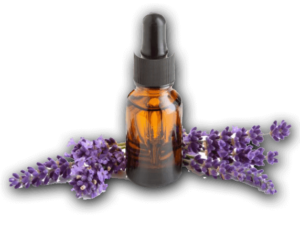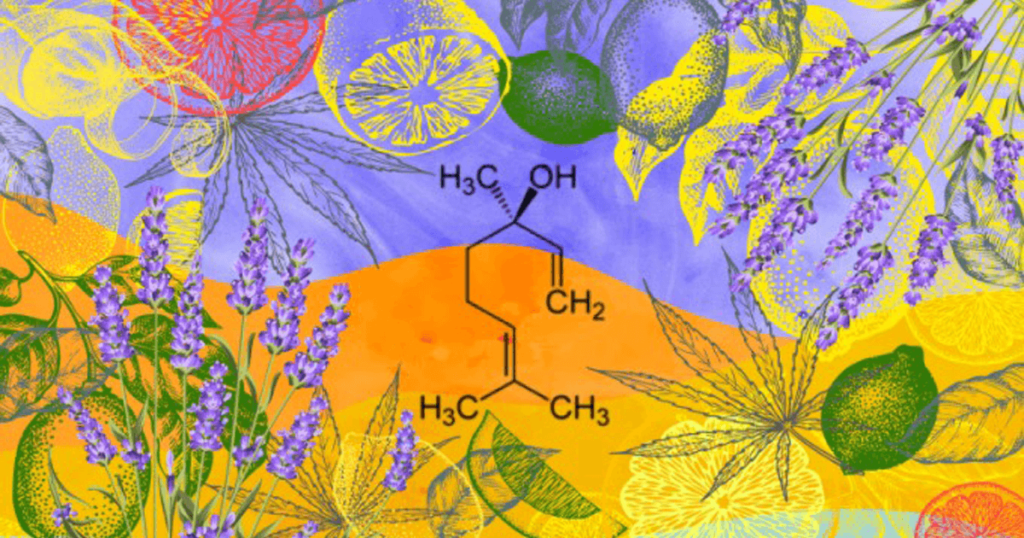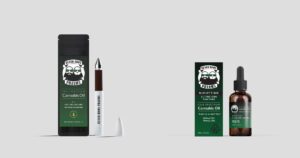D-linalool is a monoterpenoid alcohol, found in at least 200 plants, including lavender, pine needles, Korean goldenbell tree, cinnamon, rosewood, birch, and green huajiao. Like many of its monoterpenoid brethren, its distinctive aroma is used as a fragrance-enhancement in many applications, but there’s also plenty of ongoing exploration into its usages for several ailments afflicting humans. With concentrations of up to 6% of the plant’s essential oils, linalool can play an important role not only in the enjoyment of a particular cannabis chemovar but its more subtle effects as well.
LINALOOL EFFECTS
Linalool works its wonders through a balming effect on the human mind. One study in mice found a 73% reduction in general mobility when released into the ambient environment even at very low concentrations, topping the 40 others terpenes used in the study. Many of its studied effects reflect this. However, its usage in burn treatment has also been observed.
Anti-Glutamatergic: Similar to the endocannabinoid system, the human brain also has a glutamate/GABA set of neurotransmitters that work to excite (glutamate) or sedate (GABA) neuron signaling, simply put. Linalool calms this down, which in some cases can be desirable. Too much glutamate can damage neurons, so proper homeostasis of this neurotransmitter is crucial. It also works as a GABA uptake inhibitor as well.
Pain relief: In part due to its activity at certain glutamate receptors it has also been noted for its anti-nociceptive properties. Most surprising is a study that noted the essential oils of lavender’s effectiveness in treating burns without scarring. It also spurred on a desensitization of pain in a hot-plate test in mice.
Anesthesia: As a local anesthetic, linalool’s effectiveness has drawn comparisons in one study to procaine and menthol.
 Addiction: One study found that a lavender essential oil reduced morphine opioid usage in a cohort of morbidly obese patients using gastric banding — through inhalation, no less. While the proportion of linalool wasn’t mentioned, it’s presumed that it played a role, given its prevalence within the plant.
Addiction: One study found that a lavender essential oil reduced morphine opioid usage in a cohort of morbidly obese patients using gastric banding — through inhalation, no less. While the proportion of linalool wasn’t mentioned, it’s presumed that it played a role, given its prevalence within the plant.
Antioxidant Linalool reduced benzene-induced levels of advanced oxidation protein products in rats, as well as exhibited improvements in liver function compared with untreated controls.
Antimicrobial: In one study that demonstrates the power of the entourage effect, linalool was paired with nine essential oils, and in several cases enhanced the strength of the oils against several bacterial agents. It is frequently used as an antibacterial agent in food storage.
Anticonvulsant: As part of an O. Basilicum essential oil, linalool showed anticonvulsant properties, partially suppressing seizures after exposure to three convulsion-causing substances.
LINALOOL ALLERGY

The oxidized forms of the fragrance terpenes limonene and linalool are known to cause allergic contact dermatitis.
While studies have shown that linalool can be a skin irritant causing eczema and contact dermatitis in some skin-sensitive individuals, the ingredient is actually not a skin allergen in its pure form.
It only causes allergic reactions at high concentrations and when exposed to oxygen. In fact, a study showed that when oxidized linalool was added at patch testing for more than 3000 patients who wanted to find out what was causing their eczema, between 5% and 7% proved to be allergic to the oxidized form of the fragrance ingredient.
This means not all products that list this ingredient will cause irritation.
LOOKING INTO THE FUTURE
Linalool-incorporated nanoparticles have been tested as a treatment for epithelial ovarian carcinoma. Similar to other terpenes, it’s also being explored for preservative food packaging as well.

Medicine Box is your one-stop shop for the highest quality cannabis goods, heritage, and wisdom. Together, we share a common goal of cannabis culture preservation and ongoing education.
Read more Medicine Box / Beard Bros collaborations HERE
You can learn more about Medicine Box – and sign up for a free course on terpenes – HERE

















